How to Understand Chinchilla Behaviors and What They Mean
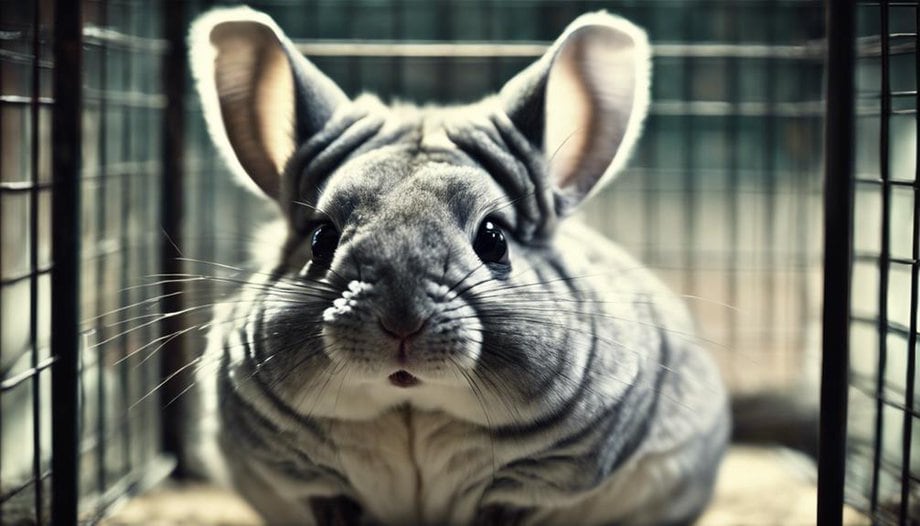
Chinchillas are known for their playful and curious nature. They exhibit various behaviors that can indicate their mood and needs. For example, if a chinchilla is hopping around and making vocalizations, it may be feeling happy and excited. On the other hand, if a chinchilla is hiding or sitting still in a corner, it may be feeling scared or stressed. Understanding these behaviors can help you better care for your chinchilla and deepen your bond with them.
One way to deepen your bond with your chinchilla is to spend quality time with them every day. This can involve playing with them, providing enrichment activities, or simply sitting near their cage and talking to them. Additionally, offering your chinchilla treats and positive reinforcement when they exhibit desired behaviors can help strengthen your bond. By paying attention to your chinchilla's behaviors and responding to their needs, you can build a strong and trusting relationship with these adorable pets.
Body Language
Chinchillas communicate primarily through body language, using a combination of postures, movements, and vocalizations to express their feelings and intentions. In social interactions, they rely heavily on visual cues to convey their emotions and establish boundaries. When feeling stressed or uncomfortable, chinchillas exhibit specific stress signals through their body language. Common indicators of discomfort include flattened ears, wide eyes, hunched posture, and fur puffing. Understanding these stress signals is crucial for caregivers to ensure the well-being of their chinchillas.
During social interactions, chinchillas may display various body language cues to communicate their mood and intentions to other chinchillas or humans. They might engage in behaviors such as grooming, chasing, or mounting to establish dominance or bond with their companions. It's essential for chinchilla owners to observe and interpret these body language signals accurately to foster positive social interactions and prevent conflicts among their pets. By paying close attention to their chinchilla's body language, caregivers can provide a supportive and enriching environment for these adorable creatures.
Vocalizations
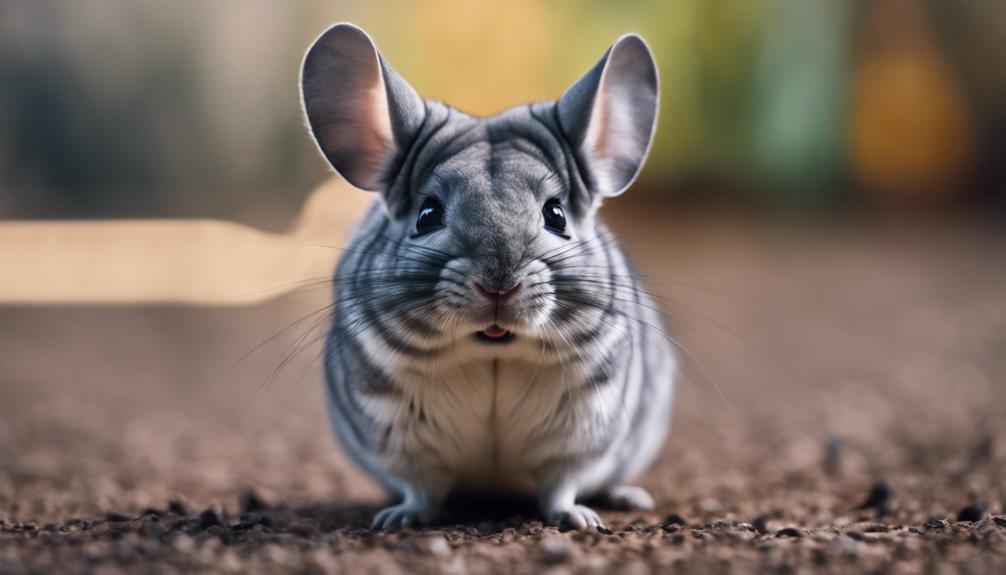
In addition to using body language, chinchillas communicate through a variety of vocalizations that convey different messages and emotions. Understanding these vocal expressions is crucial in deciphering your chinchilla's needs and feelings. Here are some common communication cues and vocal expressions to look out for:
| Vocalization | Description | Meaning |
|---|---|---|
| Barking | Loud, sharp sounds | Distress, fear, or warning |
| Chirping | Short, high-pitched noises | Contentment or seeking attention |
| Whimpering | Soft, plaintive cries | Discomfort or pain |
| Teeth Grinding | Grinding teeth together rhythmically | Stress, pain, or annoyance |
| Purring | Soft, continuous sound | Happiness or relaxation |
Chewing Behavior
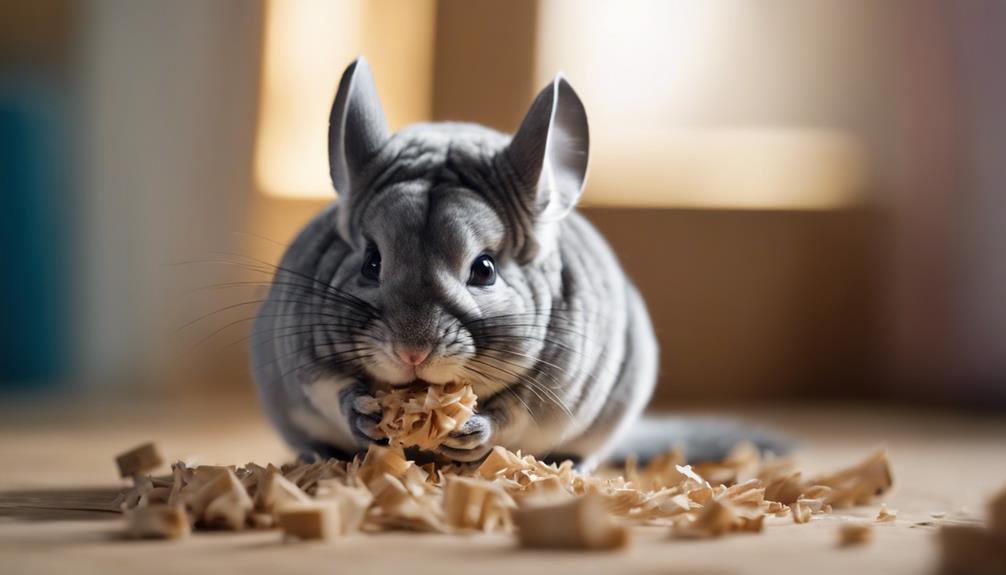
Understanding the chewing behavior of chinchillas is essential for their overall well-being and dental health. Chinchillas have teeth that continually grow, so chewing helps wear down their teeth to prevent overgrowth and dental issues. However, chinchillas may develop destructive habits if not provided with appropriate toys and training techniques. It's crucial to offer safe chew toys made of wood or other suitable materials to redirect their chewing behavior away from household items or cage accessories.
Training techniques can be used to discourage destructive chewing habits. Positive reinforcement, such as offering treats when they chew on appropriate toys, can help reinforce good behavior. Consistency is key in training chinchillas to chew on the right items.
Ensuring good dental health in chinchillas through proper chewing behavior is vital for their overall well-being. By providing suitable toys and employing effective training methods, chinchilla owners can help prevent dental issues and promote healthy chewing habits in their furry companions.
Grooming Habits
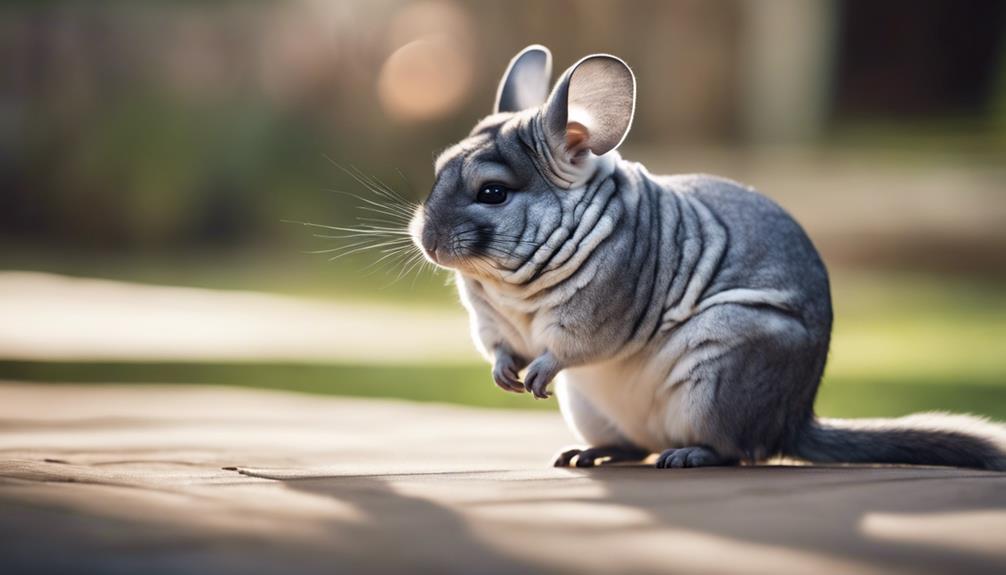
To maintain optimal health and hygiene, chinchillas exhibit meticulous grooming habits that are crucial for their well-being. Chinchillas are known for their fastidious nature when it comes to grooming, and this behavior serves several important purposes:
- Fur maintenance: Chinchillas groom themselves by meticulously cleaning their fur using their teeth and paws, keeping it free from dirt and debris.
- Bathing rituals: Despite not needing water baths, chinchillas take dust baths to maintain their fur's cleanliness and oil balance.
- Social interaction: Grooming plays a role in social bonding among chinchillas, as they groom each other to strengthen social connections within a group.
- Scent marking: Chinchillas also use grooming as a way to mark their territory by spreading their scent through grooming activities.
- Health monitoring: Through grooming, chinchillas can detect any abnormalities or parasites on their bodies, allowing them to address health issues promptly.
Understanding and observing these grooming habits can provide valuable insights into a chinchilla's well-being and social interactions within a group.
Sleeping Patterns
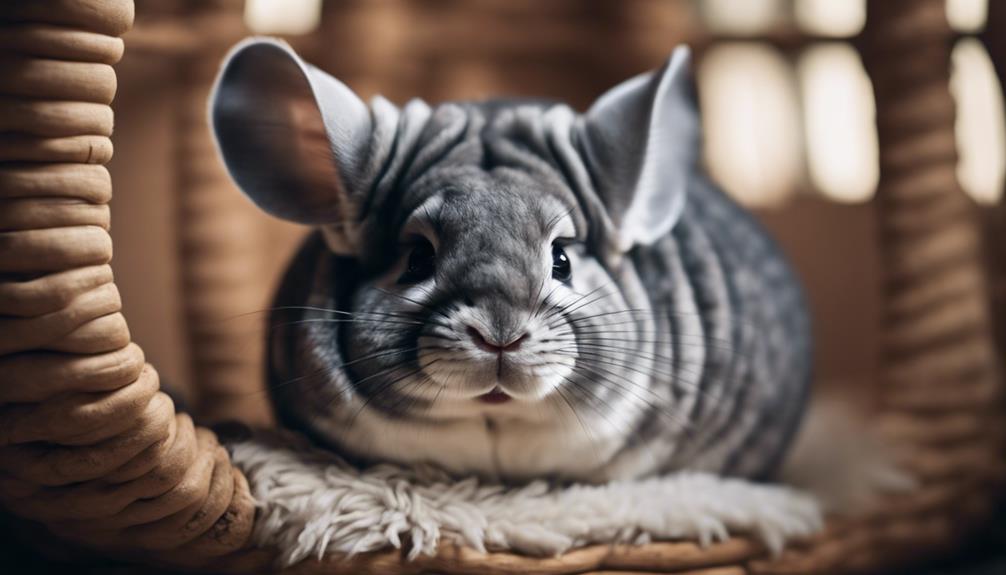
Chinchillas typically exhibit distinct sleeping patterns that are essential for their overall health and well-being. Understanding their sleep cycle is crucial in ensuring they get adequate rest. Chinchillas are crepuscular, meaning they're most active during dawn and dusk, so their sleep patterns often reflect this. They tend to take multiple short naps throughout the day, totaling around 12 hours of sleep. These naps are interspersed with periods of activity, where they may engage in grooming or exploring their environment.
Observing a chinchilla's sleeping positions can provide insights into their comfort level and overall health. Chinchillas often sleep in a crouched position with their eyes closed, but they can also sprawl out comfortably when they feel safe in their environment. It's essential to provide a quiet and dimly lit space for them to rest undisturbed. Monitoring their sleeping habits and positions can help detect any potential health issues early on, ensuring they remain happy and healthy companions.
Playful Actions
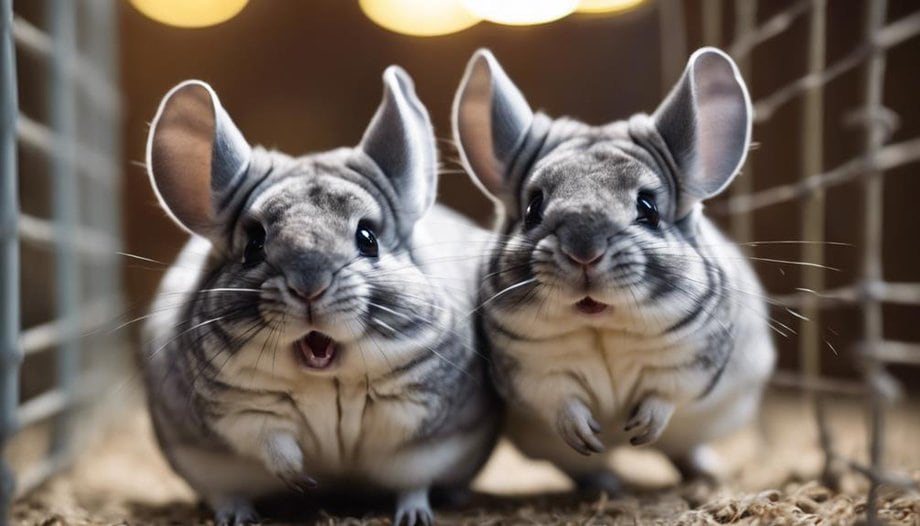
Chinchillas exhibit playful behaviors through actions like tail wagging and jumping. Understanding these behaviors can offer insight into a chinchilla's mood and overall well-being.
Observing these playful actions can also provide valuable cues for chinchilla owners to engage in enriching activities with their pets.
Tail Wagging
When observing playful chinchilla behaviors, one may notice the endearing action of tail wagging as a common expression of joy and excitement. Chinchillas exhibit various tail movements that serve as communication signals and play a significant role in their social interactions. Understanding the nuances of tail language can provide valuable insights into a chinchilla's emotional state and intentions.
- Speed: The speed of the tail wagging can indicate the level of excitement or happiness.
- Direction: The direction in which the tail moves can convey different messages in chinchilla communication.
- Position: The position of the tail relative to the body can reflect a chinchilla's mood.
- Consistency: Consistent tail wagging may signify contentment or pleasure.
- Accompanying Behaviors: Observing other behaviors alongside tail wagging can help decipher its meaning more accurately.
Jumping Behavior
Tail wagging is just one of the many expressive behaviors that chinchillas engage in, with jumping being another playful action commonly observed in these energetic rodents. Jumping behavior is a natural way for chinchillas to express joy, excitement, or even anxiety. Understanding the reasons behind their jumps can help chinchilla owners provide the best care for their pets. When it comes to training tips, positive reinforcement techniques can be used to encourage desired jumping behaviors. Additionally, jumping provides exercise benefits, helping chinchillas stay active and maintain good health.
| Training Tips | Exercise Benefits |
|---|---|
| Use positive reinforcement techniques | Helps chinchillas stay active |
| Provide rewards for desired jumping behavior | Aids in maintaining good health |
Eating Habits
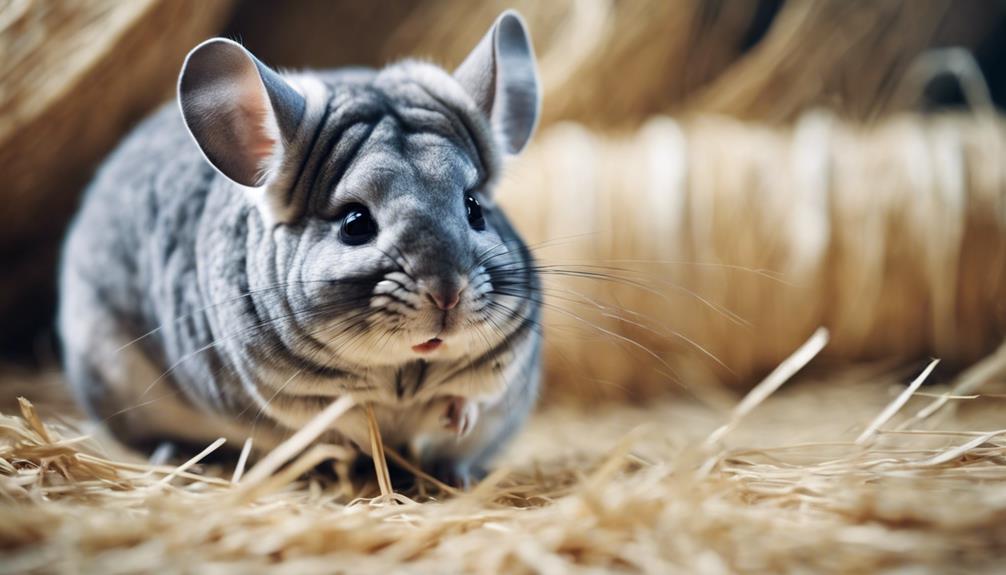
Understanding the dietary preferences of chinchillas is crucial for their overall health and well-being. Chinchillas are herbivores, and their diet consists mainly of hay, pellets, and fresh water. Here are some key points to consider when it comes to their eating habits:
- Food preferences: Chinchillas prefer Timothy hay as their main source of fiber, along with high-quality chinchilla pellets that are rich in essential nutrients.
- Meal times: Chinchillas are crepuscular, meaning they're most active during dawn and dusk. Providing food during these times aligns with their natural feeding patterns.
- Digestive health: Chinchillas have sensitive digestive systems, so it's crucial to avoid giving them treats high in sugar, fat, or moisture to prevent digestive issues.
- Treats to avoid: Foods like chocolate, nuts, seeds, and dairy should be avoided as they can cause digestive problems and lead to obesity.
- Moderation: While treats can be given occasionally, they should be limited to maintain a balanced diet and prevent health issues.
Frequently Asked Questions
How Can I Tell if My Chinchilla Is Feeling Stressed or Anxious?
When observing a chinchilla for signs of stress or anxiety, pay close attention to body language and vocalizations. Stress may be indicated by behaviors like pacing or fur slipping, while anxiety can manifest through teeth grinding or excessive vocalizations.
What Are Some Common Signs of Illness in Chinchillas?
Weight loss, lethargy, changes in appetite, and fur loss are common signs of illness in chinchillas. If a chinchilla exhibits these symptoms, it is crucial to seek veterinary care promptly for proper diagnosis and treatment.
Can Chinchillas Be Trained to Do Tricks or Respond to Commands?
While chinchillas may not perform elaborate tricks like some animals, they can be trained to respond to basic commands. Through positive reinforcement and patience, owners can bond with their chinchillas and improve communication skills.
Are There Any Specific Toys or Activities That Can Help Keep My Chinchilla Mentally Stimulated?
To keep a chinchilla mentally stimulated, provide enrichment ideas like a variety of chinchilla toys and activities. These can include chew toys, exercise wheels, and tunnels. Rotating and introducing new items regularly will help prevent boredom and promote mental engagement.
How Often Should I Take My Chinchilla to the Vet for Check-Ups?
Chinchillas should visit the vet at least once a year for check-ups. While some might worry about the costs, preventive care is crucial for catching health issues early. Regular vet visits can ensure a chinchilla's well-being.











